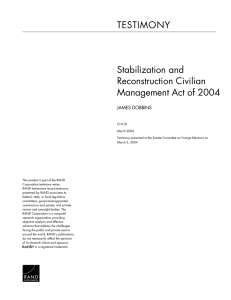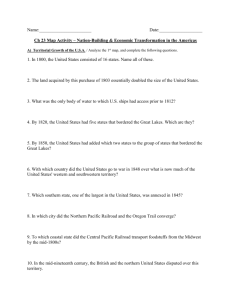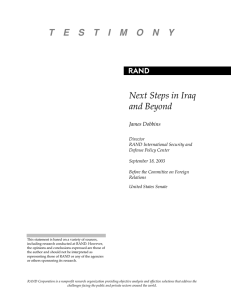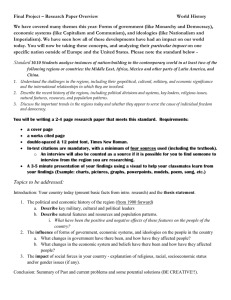Center for Domestic and International Health Security om
advertisement
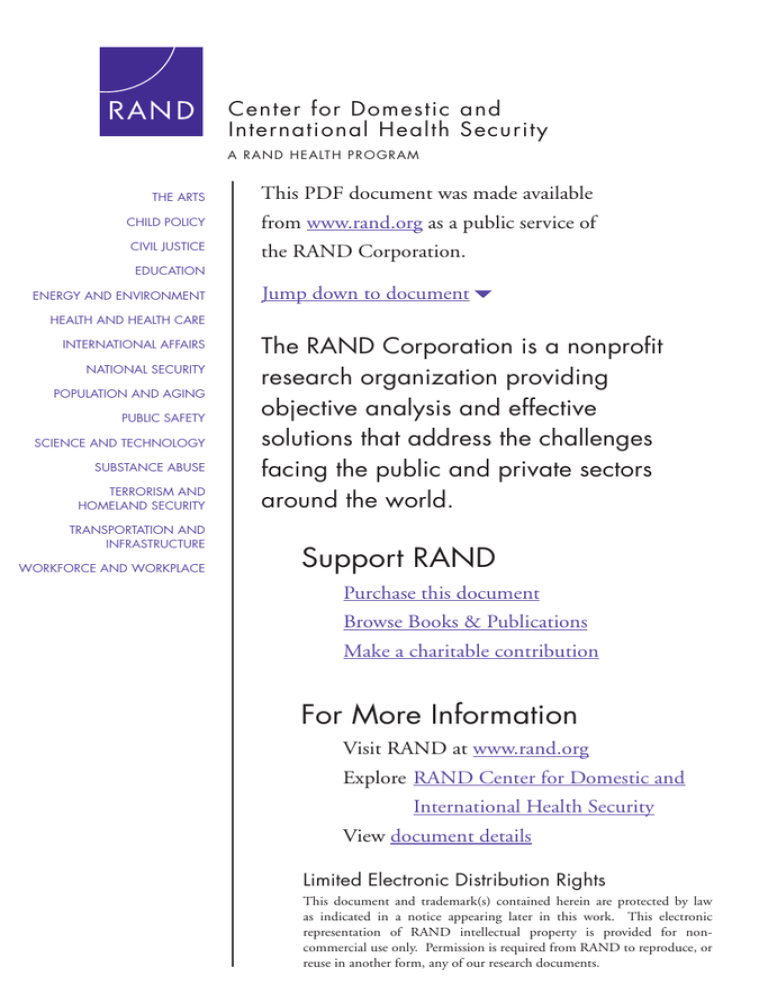
Center for Domestic and International Health Security A R A N D H E A LT H P R O G R A M THE ARTS This PDF document was made available CHILD POLICY from www.rand.org as a public service of CIVIL JUSTICE the RAND Corporation. EDUCATION ENERGY AND ENVIRONMENT Jump down to document6 HEALTH AND HEALTH CARE INTERNATIONAL AFFAIRS NATIONAL SECURITY POPULATION AND AGING PUBLIC SAFETY SCIENCE AND TECHNOLOGY SUBSTANCE ABUSE TERRORISM AND HOMELAND SECURITY TRANSPORTATION AND INFRASTRUCTURE WORKFORCE AND WORKPLACE The RAND Corporation is a nonprofit research organization providing objective analysis and effective solutions that address the challenges facing the public and private sectors around the world. Support RAND Purchase this document Browse Books & Publications Make a charitable contribution For More Information Visit RAND at www.rand.org ExploreRAND Center for Domestic and International Health Security View document details Limited Electronic Distribution Rights This document and trademark(s) contained herein are protected by law as indicated in a notice appearing later in this work. This electronic representation of RAND intellectual property is provided for noncommercial use only. Permission is required from RAND to reproduce, or reuse in another form, any of our research documents. This product is part of the RAND Corporation monograph series. RAND monographs present major research findings that address the challenges facing the public and private sectors. All RAND monographs undergo rigorous peer review to ensure high standards for research quality and objectivity. Securing Health Lessons from Nation-Building Missions Seth G. Jones Lois M. Davis • • Lee H. Hilborne Federico Girosi Rachel M. Swanger • • • C. Ross Anthony Cheryl Benard Anita Datar Garten • Anga Timilsina The research described in this report was carried out under the auspices of the RAND Center for Domestic and International Health Security, a program within RAND Health. Primary funding for the project was provided by a generous gift from David and Carol Richards. Library of Congress Cataloging-in-Publication Data Securing health : lessons from nation-building missions / Seth G. Jones ... [et al.]. v. ; cm. “MG-321.” Includes bibliographical references. Contents: Germany—Japan—Somalia—Haiti—Kosovo—Afghanistan—Iraq— Evaluating health reconstruction. ISBN 0-8330-3729-3 (pbk. : alk. paper) 1. Medical assistance—Evaluation. 2. Medical assistance, American—Evaluation. 3. Health planning—international cooperation. 4. Public health—International cooperation. 5. Nation-building—Case studies. 6. War—Health aspects. 7. Post-war reconstruction—Health aspects. I. Jones, Seth G., 1972– . II. Rand Corporation [DNLM: 1. Health Planning. 2. Delivery of Health Care—organization & administration. 3. International Cooperation. 4. Public Health. 5. Social Planning. 6. War. WA 540.1 S446 2006]. RA390.A2S43 2006 362.1—dc22 2005032231 Cover photo: AP/Emilio Morenatti Cover design by Eileen Delson La Russo The RAND Corporation is a nonprofit research organization providing objective analysis and effective solutions that address the challenges facing the public and private sectors around the world. R AND’s publications do not necessarily reflect the opinions of its research clients and sponsors. R® is a registered trademark. © Copyright 2006 RAND Corporation All rights reserved. No part of this book may be reproduced in any form by any electronic or mechanical means (including photocopying, recording, or information storage and retrieval) without permission in writing from RAND. Published 2006 by the RAND Corporation 1776 Main Street, P.O. Box 2138, Santa Monica, CA 90407-2138 1200 South Hayes Street, Arlington, VA 22202-5050 201 North Craig Street, Suite 202, Pittsburgh, PA 15213-1516 RAND URL: http://www.rand.org/ To order RAND documents or to obtain additional information, contact Distribution Services: Telephone: (310) 451-7002; Fax: (310) 451-6915; Email: order@rand.org Summary The number of nation-building missions has increased significantly since the Cold War ended.1 From 1945 to 1989, roughly half a dozen cases of nation-building occurred, ranging from U.S. and European efforts to rebuild western Germany after World War II to the United Nations Operation in the Congo from 1960 to 1964.2 Since the end of the Cold War, however, roughly 14 cases have occurred, equating to a 133 percent increase in one-third the time.3 We define nation-building as efforts carried out after major combat to underpin a transition to peace and democracy. Nationbuilding involves the deployment of military forces, as well as comprehensive efforts to rebuild the health, security, economic, political, and other sectors. The research we conducted focused on one aspect of nation-building—efforts to rebuild the public health and health care delivery systems after major combat. We looked at seven cases— Germany, Japan, Somalia, Haiti, Kosovo, Afghanistan, and Iraq. These are some of the most important cases since World War II in ____________ 1 James D. Fearon and David D. Laitin, “Neotrusteeship and the Problem of Weak States,” International Security, Vol. 28, No. 4, Spring 2004, pp. 5–43; James Dobbins et al., America’s Role in Nation-Building: From Germany to Iraq, MG-1753-RC, Santa Monica, California: RAND Corporation, 2004; James Dobbins et al., The UN’s Role in Nation-Building: From the Congo to Iraq, MG-304-RC, Santa Monica, California: RAND Corporation, 2005. 2 Based on our definition of nation-building, Cold War cases include efforts to rebuild Germany, Japan, Korea, Vietnam, the Dominican Republic, and perhaps Lebanon. 3 Examples include U.S., UN, and European efforts to rebuild Panama, Namibia, Mozambique, Haiti, Bosnia, Kosovo, Somalia, East Timor, Cambodia, El Salvador, Eastern Slavonia, Sierra Leone, Afghanistan, and Iraq. xv xvi Securing Health: Lessons from Nation-Building Missions which international institutions, non-governmental organizations (NGOs), and countries such as the United States have taken part in efforts to rebuild the health sector. These missions also have important health components. To date, a significant amount of academic and policy-relevant work has been devoted to efforts to rebuild such areas as police and military forces. Little comprehensive work has examined efforts to rebuild public health and health care delivery systems, however. The work that has been done on health tends to focus on immediate humanitarian and relief efforts rather than long-term health reconstruction. The goal of our research was to fill this void. The study has two core arguments. First, nation-building efforts cannot be successful unless adequate attention is paid to health. The area of health is strongly interrelated with other areas of nationbuilding in two ways (see Figure S.1): The health sector can have an independent impact on reconstruction and development, and other sectors can have an important impact on health. As Amartya Sen has argued, such areas as health, security, economic stabilization, and political development are deeply interrelated: Political freedoms (in the form of free speech and elections) help to promote economic security. Social opportunities (in the form of education and health facilities) facilitate economic participation. Economic facilities (in the form of opportunities for participation in trade and production) can help to generate personal abundance as well as public resources for social facilities.4 Second, successful health reconstruction depends on two factors: coordination and planning, and infrastructure and resources. The first factor includes the degree of coordination among the host government, NGOs, international organizations, and donor states, as well as the establishment of a plan for health. The second factor pertains to the existence of functioning hospitals, other infrastructure ____________ 4 Amartya Sen, Development as Freedom, New York: Anchor Books, 2000, p. 11. Summary xvii Figure S.1 Health and Nation-Building Se Ed uc ati on Economic stabilization r cu ity Successful Nation-Building Effort inf e nc rna ve B ras asic tru ctu re Go Health RAND MG321-S.1 (such as water and power systems), and donor support. External actors have significant control over some of these factors and very little control over others, such as the condition that hospitals and clinics are in when reconstruction starts. The case studies show that policymakers often fail to adequately coordinate and plan health reconstruction and to provide sufficient infrastructure and resources. Several cases we reviewed suggest that health can have an important effect—positive or negative—on security. In Japan, the introduction of powdered milk into schools created a reservoir of good will that contributed to a benign security environment. In Iraq, however, there is evidence that poor health conditions—especially poor sanitation conditions—contributed to anti-Americanism and support for the insurgency. xviii Securing Health: Lessons from Nation-Building Missions Measuring Success The study asked two related questions: How successful have past efforts to rebuild public health and health care delivery systems during nation-building operations been? What are the most important lessons learned for future operations? We define success as an improvement over time in several measures: • • • • • • Life expectancy rate Birth rate Death rate Infant mortality rate Infectious disease rate Malnutrition. We also measured success in the context of broader nation-building efforts, since success or failure in rebuilding health can affect success in other areas of nation-building, such as security, economic stabilization, and infrastructure. We used quantitative and qualitative information from a variety of resources, such as the World Bank Development Indicators data set and statistics from the Pan-American Health Organization. We also conducted a simple factor analysis to compare data across cases. Figure S.2 provides a conceptual framework for measuring the success of health interventions. It divides nation-building into five phases: pre-conflict, conflict, immediate post-conflict, reconstruction, and consolidation. All health efforts should aim to improve health conditions in relation to both the pre-conflict and the immediate post-conflict conditions. The endpoints in the figure (P1, P2, and P3) represent health outcomes after major reconstruction efforts have ended. (The reconstruction period has historically varied from less than three years to more than ten.) Endpoint P3 represents a decline in public health and health care delivery after reconstruction, which Summary xix Figure S.2 Phases of Nation-Building Health P1 Months Pre-conflict Conflict P2 P3 Several years Immediate Reconstruction post-conflict Consolidation RAND MG321-S.2 represents a failed health effort; P2 indicates little change from conflict health conditions; and P1 represents an improvement over both pre-conflict and immediate post-conflict conditions, or, in other words, a clear success. Comparative Analysis Figure S.3 plots the countries we examined in terms of the two core factors of a successful health reconstruction effort: coordination and planning, and infrastructure and resources. As can be seen, the countries are clustered into three of the four quadrants. Japan and Germany are the most successful cases; they had more of the elements that contribute to a successful health reconstruction effort. Kosovo and Iraq are mixed cases; they had high levels of some indicators and low levels of others. And Haiti, Somalia, and Afghanistan had low levels of all indicators and thus are the least successful. xx Securing Health: Lessons from Nation-Building Missions Figure S.3 Distribution of Countries Infrastructure and resources 1.0 Japan 0.8 Germany Kosovo 0.6 Iraq 0.4 Afghanistan 0.2 Haiti 0 Somalia 0.2 0.4 0.6 0.8 1.0 Coordination and planning RAND MG321-S.3 Note that none of the seven countries we examined is in the lower right quadrant, where countries would lie if their health reconstruction coordination and planning efforts were strong but their infrastructure and resources at the beginning of reconstruction were insufficient. Cases such as the United Nations effort in East Timor that began in 1999 might fall into this category. Lessons Learned The study also provided qualitative findings. Learning from and applying these lessons will improve the chances of success in rebuilding health. It will also increase the likelihood of improving water and sanitation conditions, infectious disease rates, mortality and morbidity rates, and food and nutrition conditions, and it will increase the likelihood that broader nation-building and development objectives will be achieved. The lessons fall into six categories: health as an independent variable, the impact of other sectors on health, coordi- Summary xxi nation, sustainability and tipping point, exit strategies, and performance metrics. Health as an Independent Variable Unless adequate attention is given to health, nation-building efforts cannot be successful. Indeed, health can have an important independent impact on nation-building and overall development. Several of the cases show that security is significantly impacted by the role health plays in helping to win “hearts and minds,” an objective whose importance is illustrated by cases such as Iraq and Somalia. In both of these cases, the inability to win hearts and minds contributed to insurgency, warlordism, and an unstable security environment. Counterinsurgency experts have long argued that winning hearts and minds is a key—if not the key—component in establishing peace. Health can play an important role in the effort by, for example, offering tangible health programs to the local population and meeting basic health needs, such as improving sanitation and nutrition conditions. Such programs should be designed to gain support for the host country, rather than for the United States or other outside actors; the local government should be the entity winning the hearts and minds of the population. In the early stages of nation-building operations, the absence of a local government may make it difficult to win hearts and minds. This was the case during the operations in Germany, Somalia, Kosovo, and Iraq. Over time, however, political authority invariably shifts to local control. When it does, programs must be designed to gain support for the local government. Health can have an important negative effect on security, as well. In Iraq, for example, there is some evidence that poor health conditions—especially poor sanitation conditions—contributed to anti-Americanism and support for the insurgency. Most early reconstruction efforts in the Iraqi health sector went into activities that were not immediately visible to Iraqis, such as establishing a surveillance system and creating a statistical database of hospitals and clinics. Maximizing the effectiveness of health as an independent variable means paying close attention to the sequence of health steps. Nation-building programs will generally follow three broad, se- xxii Securing Health: Lessons from Nation-Building Missions quenced phases: immediate post-conflict, reconstruction, and consolidation. During the immediate post-conflict phase, at least three types of emergency health situations should take priority. Failure to address them well or quickly can complicate reconstruction in other areas and lead to animosity among the local population, whereas success can help win hearts and minds. First, the clinical consequences arising after the use of weapons of mass destruction must be quickly and adequately addressed. In Japan, this was not done; the treatment of survivors was left largely to the Japanese themselves. Allied doctors eventually brought in penicillin and plasma, but the slow and inadequate treatment of victims contributed to high casualty rates. Second, the outbreak—or potential outbreak—of communicable diseases needs to be met quickly to prevent spreading. Third, basic public health needs, such as food and sanitation, should be met as quickly as possible. Famine has been a particular concern. After Somali President Siad Barre was deposed in 1991, an estimated 300,000 people died of starvation over the next two years. The United Nations and United States provided immediate humanitarian assistance and saved an estimated additional 300,000 Somalis from famine. Impact of Other Sectors on Health Health conditions are deeply impacted by other key sectors, including security, basic infrastructure (such as power and transportation), education, governance, and economic stabilization. Amartya Sen argues that the linkages between these sectors are empirical and causal: [T]here is strong evidence that economic and political freedoms help to reinforce one another. . . . Similarly, social opportunities of education and health care, which may require public action, complement individual opportunities of economic and political participation and also help to foster our own initiatives in overcoming our respective deprivations.5 ____________ 5 Sen, Development as Freedom, p. xii. Summary xxiii The health sector is particularly sensitive to security in at least two ways: through direct effects, such as the inability of patients to visit doctors; and through indirect effects, such as the inability of health care facilities to function properly. A lack of security can impede progress in the reconstruction of water plants and hospitals, slow immunization campaigns, restrict delivery of needed supplies to health care facilities, and affect the labor force if healthcare providers are intimidated or threatened with kidnapping. Patients can also be deterred from seeking health care because of security concerns. Situations such as this (Iraq, for example), where there is a pervasive lack of security, cannot be fixed by ad hoc measures, such as providing security guards to hospitals and guarding water plants and pipes. The success of the health sector is also tightly linked with progress in other sectors, such as basic infrastructure. In Iraq, for instance, hospitals and clinics operated at partial capacity and had to use power generators provided by international organizations. In general, a lack of clean water, sanitation, or power increases the likelihood of acute disease outbreaks or widespread epidemics, and makes it difficult to build a functioning health system. International organizations may spend time and resources refurbishing hospitals and clinics, training staff, and providing equipment. But unreliable power nullifies much of this effort. The success of the health care system is also linked to reconstruction of the financial, judicial, and education systems. For example, if financial systems are not working, it is difficult to acquire supplies and capital equipment, and equally challenging to develop health-financing mechanisms. Coordination The coordination of health efforts is a key challenge during reconstruction. Indeed, the World Bank argues that past nation-building efforts have suffered from “a lack of an overarching nationally-driven plan to which all donors agree, resulting in fragmentation, gaps or xxiv Securing Health: Lessons from Nation-Building Missions duplication in aid-financed programs.” 6 Poor coordination can weaken fragile health systems by scattering assistance to an assortment of health projects and failing to sufficiently tackle key priorities. In some ways, coordination and planning were easier in the post–World War II cases of Germany and Japan because there were fewer actors, which made it easier for government officials to coordinate policies and communicate among health personnel. The number of actors involved in health reconstruction has exponentially increased since the end of the Cold War. The greater the number of actors, the more difficult the coordination.7 Two steps can help improve mission coordination: encouraging and rationalizing a leadstate or lead-organization system for health, and learning from and replicating successful on-the-ground organizational innovations. First, the need to overcome coordination and collaboration problems makes it important to establish institutional arrangements that increase efficiency in rebuilding health. There are a variety of options: donor coordination units within a host state’s Ministry of Health, a lead national actor, lead regional or local actors, regular collective Ministry of Health consultations with donors, and sectorwide approaches. A lead actor approach is usually the most effective coordinating strategy for planning and funding, especially when the host government is barely functional. In the health sector, experience suggests that the lead actor(s) should be an international organization rather than a state. It can be difficult to agree on a lead actor, since donor states, international institutions, and NGOs generally have different priorities, interests, and strategies. But a lead actor is critical to ensure efficiency and effectiveness. This can include coordinating and overseeing the undertaking of joint assessments, preparing shared ____________ 6 United Nations Development Programme and World Bank, An Operational Note on Transitional Results Matrices: Using Results-Based Frameworks in Fragile States, New York: United Nations Development Group and World Bank, January 2005, p. 2. Also see Health Policy Formulation in Complex Political Emergencies and Post-Conflict Countries: A Literature Review, London: London School of Hygiene and Tropical Medicine, November 2002. 7 Mancur Olson, The Logic of Collective Action: Public Goods and the Theory of Groups, Cambridge, Massachusetts: Harvard University Press, 1971, p. 2. Summary xxv strategies, coordinating political engagement, establishing joint offices, and introducing simplified arrangements, such as common reporting and financial requirements. In theory, the lead actor can be a donor state, international organization, or NGO. In practice, however, only states and international organizations have the resources and legitimacy necessary to be lead actors. Two elements crucial to the task of establishing a lead actor are buy-in from the host government and support from key donors, international organizations, and NGOs. Second, there is a strong need to consolidate lessons learned and best practices in coordinating activities. NGOs and other organizations have worked out effective ad hoc organizational arrangements at national and local levels to improve coordination. One important aspect should be to coordinate with international institutions or NGOs that were involved in health and health-related efforts before and during the conflict. Their experience provides an invaluable understanding of the health care system, the health status of the population, and the major health challenges within a country. Since reliable statistical information on health conditions is often unavailable during the initial post-conflict phase, prior knowledge is crucial. Bilateral donors, international institutions, and NGOs should utilize actors with in-country experience to assist in coordination and planning. Sustainability and Tipping Point Health sector reform must encourage long-term sustainability. Indeed, the ultimate objective of health reconstruction should be to reach a “tipping point”: the point at which the local government begins to assume substantial responsibility for managing the health sector. This point will be different in every nation-building case, and will likely take longer to reach in less-developed states. It took Germany approximately two and a half years to reach the tipping point; however, U.S. advisors continued to observe, inspect, advise, and report on health activities. Haiti never reached the tipping point. The United States largely withdrew after three years, and the Haitian government never developed the capacity to implement health programs and to administratively operate them. xxvi Securing Health: Lessons from Nation-Building Missions The training of indigenous personnel is critical to sustainability. Without it, the programs neither reflect favorably on the host government nor remain effective once outside forces and personnel have departed. Another critical aspect is assessment of the national and private health institutions’ capacity to engage in needs assessment and implementation. Capacity has important implications for recovery and planning. From an operational perspective, it makes sense to distinguish between two types of post-conflict situations: strong national capacities and weak national capacities. These distinctions should not be regarded as absolute, but as two ends of a continuum. Most countries are located between these extremes. In countries with strong national health capacities, such as Germany after World War II, health progress may be more rapid. Since national contributions and ownership are likely to be high, planning can be oriented beyond the short-term (0 to 18 months) to include the medium-term (18 to 36 months) recovery and development needs. In countries with weak health capacities, national and private health institutions usually lack the capacity to make substantial contributions to the needs assessment and implementation. In Somalia, warlords did not support relief efforts and attacked, looted, or extorted payments from relief convoys. In Afghanistan, tribes and local strongmen, rather than the central government, have historically controlled most of the country, making it difficult to create a selfsufficient and sustainable health system. The variation in initial nation-building conditions places a premium on correct determination of governance institution effectiveness and the nature of the conflict. Much like Afghanistan, states with a weak national capacity can face a series of challenges after major conflict: • Severely deteriorating health conditions, especially if civilians and civilian structures were targets of violence • Institutional collapse • Social cleavages between groups manipulated by the parties to the conflict • Lack of accountability mechanisms because there is no legitimate government. Summary xxvii The curves of decline and recovery are likely to be different for these cases, especially when there has been a long-term degradation of health. Challenges are deeper, and progress should be expected to be slower before reaching a tipping point. The health infrastructure, administrative capacity, and physical infrastructure may have ceased to exist—or may never have existed at all. Such situations require a reconstruction effort strongly shaped by the goal of development. In Afghanistan, the international community geared up for a standard post-conflict reconstruction effort instead of acknowledging that what it largely faced was a development challenge. If development is the goal, an important question arises: Will health recovery plans perpetuate a tradition of national dependence on the external design, delivery, and financing of health care that will jeopardize sustainability? Unfortunately, the main health challenges in countries with weak national capacities are not amenable to quick fixes. The population must become stronger and healthier through improved nutrition and access to clean water and sanitation. A new generation of health care professionals has to be recruited, trained, and motivated to work in rural areas. Some long-standing habits and attitudes, particularly related to marriage, family, and the status of women, must change. And the country needs years of stability and security for these changes to occur and take hold. Exit Strategies Short-term medical care is valuable, but to change a state’s health care system requires time and sustained effort. In Haiti and Somalia, for example, outside powers wanted to withdraw as fast as possible. The search for a fixed exit strategy is illusory, if this means a certain date in the near future when full control of health care facilities can be handed back to local authorities. Exit requires a functioning health care system that has at least reached the tipping point. Duration is a critical variable and cuts across all aspects of reconstruction. Based on the cases we examined, no effort to rebuild health after major combat has been successful in less than five years. The cases of postwar Germany and Japan underestimate the time needed xxviii Securing Health: Lessons from Nation-Building Missions to rebuild health because both countries were fairly developed in 1945. Nation-building efforts in developing countries, such as Somalia and Afghanistan in this study, would have to continue for much longer than five years to be successful. With little health infrastructure to begin with, such countries require the time needed to achieve local buy-in, build hospitals and clinics, conduct immunization programs, train health personnel, and improve sanitation and nutrition conditions. An interesting point about duration is that while staying for a long time does not always guarantee success, leaving early usually assures failure. U.S.-led efforts to rebuild Somalia and Haiti were shortlived. The bulk of health assistance lasted for only three years, and continuing political instability in Haiti led the international community to withhold all aid by 2000. The cost of early departures is clear: It is difficult to ensure success in rebuilding health. This brings us to the last lesson. Performance Metrics Health programs have often fallen into the trap of emphasizing outputs, rather than outcomes, as a measure of success. Success should not be measured by the number of hospitals constructed or the percentage of doctors and nurses trained. These are important, but they tell us little about the overall state of health. Health assistance can be broken into three categories: inputs, outputs, and outcomes. Inputs are the amount of resources used in reconstructing health, such as the amount of financial assistance and international personnel deployed. Outputs are the first-order results of the assistance program—for example, trained doctors and nurses, and functional hospitals. (Many people call these outputs proximate or intermediate outcomes.) Outcomes are conditions that directly affect the public. They are not what governments and international institutions do; rather, they are the consequences of what they do. Nation-building missions may want to create a performance matrix that lists key health goals, inputs, outputs, and outcomes over time. This effort should include gathering information on baseline conditions and, perhaps, relevant Summary xxix non-health indicators. Most importantly, the matrix should track metrics over the course of reconstruction to monitor whether they are improving or getting worse. Without the ability to measure performance, policymakers lack an objective method for judging success and failure in ongoing crises, which makes midcourse corrections more difficult. Key measures of health outcomes include life expectancy, birth rate, death rate, infant mortality rate, infectious disease rate, and malnutrition. Since these outcome measures may not always be readily available, more-tactical and short-term measures (e.g., vaccination rates, percentage of births with skilled attendance, access to timely basic health care, and adequacy of health care supply) may also be appropriate to give policymakers some indication of performance. Building such assessments into current and future assistance programs and encouraging host nations to undertake such assessments will make foreign actors better placed to optimize assistance programs. Performance indicators should also vary somewhat for different countries. Some more-developed states may face a window of opportunity for rapid structural reform. For some less-developed states, however, rapid structural reform may be destabilizing, so immediate priorities should instead focus on rebuilding familiar administrative and service delivery functions. The timelines of performance measures should be adapted to a country’s particular circumstances. Moving Forward What are the policy implications of rebuilding health for international institutions, NGOs, and donor states? Many recent cases, such as Afghanistan and Iraq, have reinforced well-worn lessons. Of the many lessons about health and nation-building that the international community learned during the 1990s, few have been applied in Afghanistan or Iraq. Applying these lessons will not ipso facto guarantee success. But, on the basis of our findings, we believe it will vastly improve the xxx Securing Health: Lessons from Nation-Building Missions chances of success, as measured by improvements in sanitation conditions, infectious disease rates, mortality and morbidity rates, and nutrition conditions. Our findings also support the use of these metrics as criteria by which to judge success. Given the likelihood of future nation-building missions, it may be worthwhile for interdisciplinary experts to define the possible dimensions of “success.” While each nation-building mission will, of course, differ somewhat in overall objectives and data availability, it is nonetheless critical to develop a framework for monitoring and measuring inputs and outputs.
